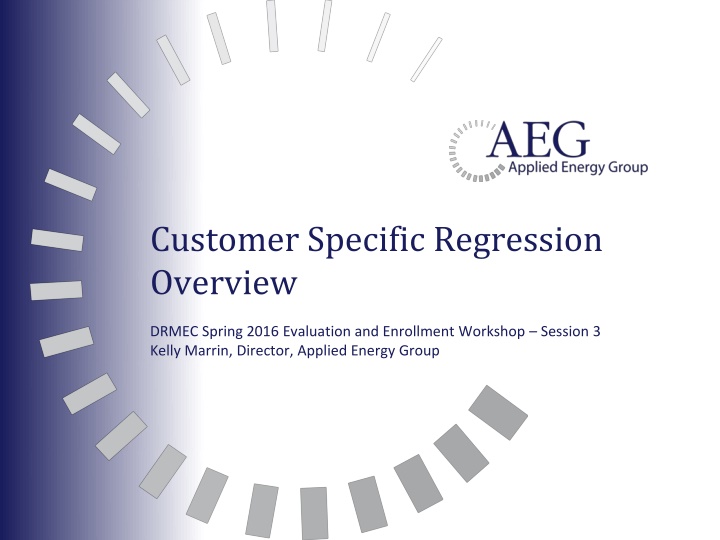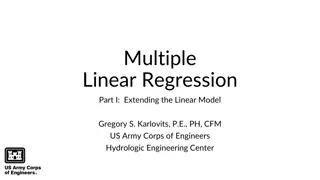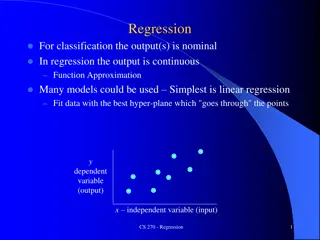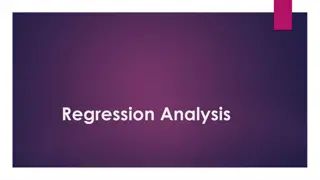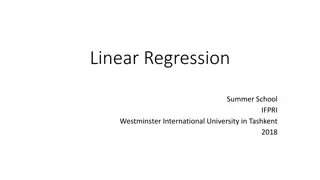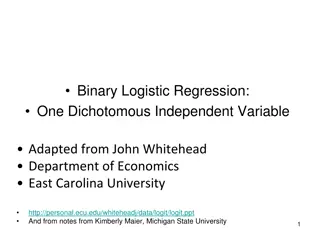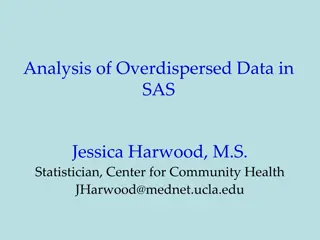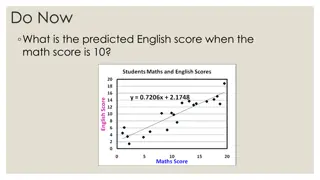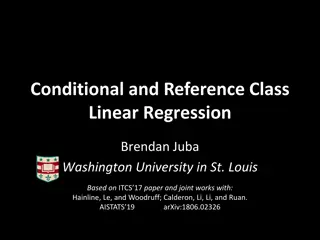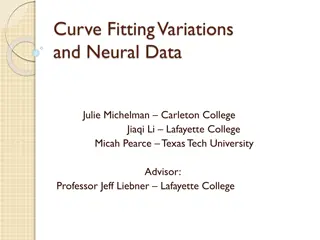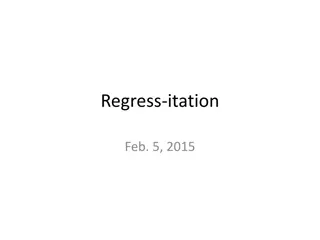Overview of Customer-Specific Regression Model Development and Optimization Process
This overview covers the process of developing customer-specific regression models, including candidate model development, variable combinations, optimization process, and selecting the best model for each customer based on forecasting accuracy. It also discusses the post-implementation results of the regression model aggregation at the customer level.
Download Presentation

Please find below an Image/Link to download the presentation.
The content on the website is provided AS IS for your information and personal use only. It may not be sold, licensed, or shared on other websites without obtaining consent from the author.If you encounter any issues during the download, it is possible that the publisher has removed the file from their server.
You are allowed to download the files provided on this website for personal or commercial use, subject to the condition that they are used lawfully. All files are the property of their respective owners.
The content on the website is provided AS IS for your information and personal use only. It may not be sold, licensed, or shared on other websites without obtaining consent from the author.
E N D
Presentation Transcript
Customer Specific Regression Overview DRMEC Spring 2016 Evaluation and Enrollment Workshop Session 3 Kelly Marrin, Director, Applied Energy Group
Agenda and Overview Candidate model development Optimization process Obtain subgroup level results 2
Candidate Models Building blocks of a customer-specific regression model Variable Description Variable Name Baseline Variables Weather related variables including average daily temperature, multiple cooling degree hour (CDH) terms with base values of 75, 70, and 65 depending on service territory, and lagged versions of various weather related variables Combinations of these variables were used to create approximately 35 different candidate models for the CBP and AMP participants Weatheri,d A series of indicator variables for each month Monthi,d A series of indicator variables for each day of the week DayOfWeeki,d An indicator for the year 2015 Yeari,d Equals one on event days of other demand response programs in which the customer is enrolled OtherEvti,d The average of each day s load in hours 5 a.m. through 10 a.m. MornLoadi,d Impact Variables We created weather sensitive and non-weather sensitive models An indicator variable for aggregator program event days Pt,d An indicator variable for aggregator program event days interacted with weather terms An indicator variable for aggregator program event days interacted with the year 2015 P * Weathert,d P * Yeari,d An indicator variable for aggregator program event days interacted with an indicator for non-typical event windows (outside of HE 16-19) P*NonTypEventi,d 3
Optimization Process Selecting the best model for each customer Identify event-like days to be used in the out-of- sample test Goals: (1) Accurately predict the actual participant load on event days, and, (2) Accurately predict the reference load in absence of an event. Remove out-of-sample days and fit all candidate models to the remaining data for each customer Solution: Use the model results to predict (forecast) usage on the out-of-sample days and calculate the MAPE and MPE Typical forecasting approach minimizing MAPE and MPE with in- and out-of-sample testing Also calculate the MAPE and MPE on actual event days (in-sample days) Select the candidate model for each customer with the minimum MAPE and MPE across both the out-of-sample and in-sample days 4
Ex Post and Ex Ante Results Customer specific regression model aggregation Once the best model has been selected for each customer, we estimate the reference load and impact at the customer level as follows: oObtain the actual and predicted load on each hour and day oUse the coefficients and the baseline portion of the model to predict each customer s reference load oCalculate the impact as the difference between the reference load (the estimate based on the baseline variables) and the predicted load (the estimate based on the baseline + impacts variables) on each event day. We estimate the aggregate impacts by summing individual impacts to any subgroup level including: oLCA, Industry Type, Size category, Aggregator, or any other subgroup required by the utility Ex ante results leverage the same models, but use weather scenarios and enrollment forecasts as inputs rather than actual weather and enrollment 5
Load Impact Evaluation of Aggregator Demand Response Programs DRMEC Spring 2016 Evaluation and Enrollment Workshop Session 3 Kelly Marrin, Analysis Director
Agenda Program Descriptions Ex Post Methodology Ex Post Impacts Ex Ante Methodology Enrollment Forecast Ex Ante Impacts Ex Post and Ex-Ante Comparison Key Findings 7
Program Description Capacity Bidding Program (CBP) IOUs: PG&E, SCE, and SDG&E Program Basics: oStatewide aggregator-managed DR program oOperates May-Oct for PG&E and SDG&E and year-round for SCE oParticipants must meet eligibility requirements oParticipants receive monthly capacity payments based on nominated load + energy payments based on kWh reductions during events oCapacity payment may be adjusted based on performance oParticipants receive monthly the capacity payment according to their nomination if no events called oDual enrollment in energy-only DR program with a different notification type is allowed Events: oTriggered by IOU or CAISO market award oDay-ahead (DA) and day-of (DO) notice options oEvent durations of 1-4 and 2-6 hours in 2015 and forecast oUp to 30 event hours/month SCE and PG&E; 44 hours/month for SDG&E o11 a.m. to 7 p.m. non-holiday weekdays 8
Program Description Aggregator Managed Portfolio(AMP) IOUs: PG&E and SCE Program Basics: o3rd party aggregators contract with IOUs oAggregators create own DR programs and contract with customers oOperates May-Oct for PG&E and varies for SCE oCustomers must meet eligibility requirements oPG&E: system and local products; local allows dispatch by Sub-LAP oSCE: system and local dispatch pre-integration; dispatch by Sub-LAP post-integration oPenalties for not delivering committed load reduction oCustomers may dually enroll in other DR programs (CPP, PDP, DBP, OBMC) Events: oTriggered by IOU or CAISO market award oOnly DO notification contracts in 2015 and forecast oUp to 80 event hours/year for PG&E; varies for SCE o11 a.m. to 7 p.m. non-holiday weekdays for PG&E; varies for SCE 9
Ex Post Impacts Methodology Customer-specific regression models Optimize the models for each customer through a process which includes the minimization of in-sample and out-of-sample MAPE and MPE Example: SDG&E Actual & Predicted Loads on Event-Like Days 10
Ex Post Impacts Program Dispatch and Event Summary Represents a significant increase in hours called and number of events relative to 2014 (2014 events ranged from 7 15) PG&E and SDG&E typical event hours are HE 16 - 19 SCE events ranged from 1 to 6 hours and HE 14-19 About half of SCE CBP events were called during the winter months Day-Ahead Day-Of Actual Hours of Use Actual Hours of Use Number of events Hours of Availability Number of events Hours of Availability Program IOU PG&E 16 150 72 18 150 63 CBP SCE 61 150 126 42 150 138 SDG&E 42 220 168 24 220 96 PG&E 18 80 75 not applicable AMP SCE 10 80 23 not applicable 11
Ex Post Impacts Average Event Hour Overall, impacts generally fell short of nominated capacity (with the exception of SDG&E DA) DO products have at least 2X more participants than the DA products DO impacts are generally, but not always, higher than DA impacts PG&E AMP has the highest impact with 97 MW and 1,417 participants Day-Ahead Day-Of Aggregate Impact (MW) Nominated Capacity (MW) Event Temp ( F) Aggregate Impact (MW) Nominated Capacity (MW) Event Temp ( F) Program IOU PG&E 15.9 23.7 90 20.0 23.9 90 CBP SCE 1.0 2.2 85 16.4 25.7 87 SDG&E 7.8 7.6 80 5.7 6.8 82 PG&E not applicable 96.9 120.4 93 AMP SCE not applicable Confidential Results are average event-hour impacts for average summer (May-Oct) event day in 2015. Average event hours are HE 16 19 for all but SCE AMP, which is HE 14 15. 12
Ex Post Impacts Example Load Profiles and Impacts SDG&E CBP DA 1-4 Hours: Average Hourly Per-Customer Impact, Average Event Day PG&E AMP DO: Average Hourly Per-Customer Impact, Average Event Day 13
Ex Post Impacts Utility System Peak Hour Day-Ahead Day-Of Aggregate Impact (MW) Event Temp ( F) Aggregate Impact (MW) Event Temp ( F) Program IOU PG&E 13.4 94 Confidential CBP SCE Confidential no event called SDG&E 7.9 96 6.9 93 PG&E 95.9 97 not applicable AMP SCE Confidential not applicable Results are for the 2015 utility system peak hour. Weather across all three utilities is similar PG&E s AMP program has the highest impact at 96 MW PG&E s Peak: 6/30/2015 (HE 18); SCE s Peak: 9/8/2015 (HE 17); SDG&E s Peak: 9/9/2015 (HE 16) 14
Ex Post Impacts Statewide System Peak Hour Day-Ahead Day-Of Aggregate Impact (MW) Event Temp ( F) Aggregate Impact (MW) Event Temp ( F) Program IOU PG&E 21.8 94 17.6 94 CBP SCE Confidential 28.1 92 SDG&E 7.3 93 6.9 92 PG&E 84.3 97 not applicable AMP SCE Confidential not applicable Results are for the 2015 statewide system peak hour. Impacts range from 7 MW to 84 MW PG&E s AMP program has the highest impact at 84 MW CAISO Peak 9/10/2015 (HE 17) 15
Incremental Impacts of TA/TI & Auto DR Methodology Euclidean distance approach to match enabled and non-enabled participants by product and industry Statistical difference-in-differences approach for incremental impacts ??????????? ??????? = ?????????? ??????????? ?????????? ??????????? PG&E CBP Impacts Difference in Differences PG&E CBP Match Reference Loads on an Event Day 16
Incremental Impacts of TA/TI & AutoDR Ex post Incremental Impacts Average Summer Event On average, enabling technology allowed for an incremental ~25% (3.4MW) impact over similar non-enabled customers Some caveats. . . Impacts were not significant across all products at the product level PG&E AMP control group was less well matched than the others, and showed positive impacts across all hours (including event hours) Incremental Impact Per-Customer (kW) Number of Enabled Customers Aggregate (MW) Program Product IOU Significant All DA & DO PG&E 125 11.5 1.4 Yes CBP DO 1-4 hour SCE 72 9.8 0.7 Yes All DA & DO SDG&E 97 6.2 0.6 Yes AMP* All DO PG&E 68 10.2 0.7 Yes *Not enough SCE AMP events with similar durations to estimate statistically significant impacts. Actual Ex Post impacts achieved by AutoDR and TA/TI participants were generally lower than the total kW load shed test results (SDG&E s impacts were slightly higher) 17
Ex Ante Impacts Methodology Use the customer-specific regression models from the in ex post analysis Predict per-customer weather-adjusted impacts for all subgroups o Apply Utility and CAISO weather scenarios o Because Aggregators strategically call on participants with a goal of meeting a specific MW nomination we assume the following: Assume no weather sensitivity in the impacts, therefore 1 in 2 is equal to 1 in 10 Assume consistent response across months in accordance with a single monthly nomination value - applied impacts under July 1-in-2 to each month in forecast Use enrollment forecasts from IOUs to forecast aggregate impacts o Enrollment was derived based on Per-customer impacts Contractual MW Historical performance 18
Ex Ante Impacts Enrollment Forecast Number of Service Accounts Avg. Summer Event 2015 (Each Year) 200 569 55 670 122 223 1,417 Confidential 2016-2017 2018-2026 (Each Year) Program Utility Notice DA DO DA DO DA DO DO DO 175 609 30 814 122 220 175 609 30 PG&E CBP SCE 1,264 122 220 1,459 SDG&E PG&E SCE 1,459 AMP Drivers PG&E and SDG&E s CBP and AMP enrollment forecasts stay relatively steady and are consistent with current enrollment SCE s CBP and AMP programs are an exception, DO enrollment increases from 670 in 2015 to 1,264 in 2018 driven by the assumption that AMP will discontinue after 2017 19
Ex Ante Impacts Average Event Hour, August 2016/2017 Utility Peak 1-in-2 Per-Customer Impact (kW) Aggregate Impact (MW) Program Utility Notice DA DO DA DO DA DO DO DO Accounts 175 609 30 814 122 220 120.9 28.1 41.3 37.2 62.9 20.7 55.1 21.2 17.1 PG&E 1.2 30.2 7.7 4.6 80.4 CBP SCE SDG&E PG&E SCE 1,459 AMP Confidential Results are average event-hour impacts for August peak day in 2016 or 2017. As expected, ex ante impacts are similar to the 2015 ex post impacts Keep in mind that the aggregate impacts vary from the ex post based on the weather-adjusted per-customer impacts, the enrollment forecast, and embedded assumptions 20
Ex Ante Impacts Comparison of current and previous forecast Current Forecast Previous Forecast Aggregate Impact (MW) Aggregate Impact (MW) Program Utility Notice DA DO DA DO DA DO DO DO Accounts Accounts 175 609 30 814 122 220 21.2 17.1 1.2 30.2 7.67 4.55 80.4 Confidential 37 530 129 5.5 9.9 5.5 48.8 11.9 10.4 102.0 PG&E CBP SCE 1,162 159 284 1,511 SDG&E PG&E SCE 1,459 AMP Results are average event-hour impacts for August peak day in 2016 or 2017. Utility Peak 1-in-2 weather conditions. PG&E CBPincrease - increased participation and nominated load during 2015 SCE and SDG&E CBPdecrease decreased participation and nomination expected PG&E AMPdecrease aggregators lowered their commitment level for 2016 as part of their participation in the DR auction mechanism (DRAM) 21
Key Findings Ex Post Overall, impacts generally fell short of nominated capacity (with the exception of SDG&E CBP DA) Integration with the CAISO has resulted in a significant increase in program utilization DO products have at least 2X more participants than the DA products, and generally have higher impacts than DA Technology enabled customers show higher incremental impacts than their non- enabled counterparts, however, they still fall short of their load shed test results in most cases Ex Ante PG&E and SDG&E forecast impacts and enrollment that are consistent with 2015 impacts for CBP SCE forecasts a significant increase in enrollment and impacts for the CBP program when AMP enrollment drops to zero after 2017 PG&E forecasts a drop in AMP impacts consistent with the aggregators reduction in nominated future MW While we see a fluctuation in per customer impacts across years, and across a single season, aggregate impacts are driven largely by nominated MW 22
Project Contributors IOU Contributors AEG Contributors Kelly Marrin, Director Gil Wong, PG&E Project Manager Analysis Director Overall Project Manager kmarrin@appliedenergygroup.com Gxwf@pge.com Abigail Nguyen, Principal Analyst Kathryn Smith and Lizzette Garcia-Rodriguez Analysis Lead SDG&E Project Managers anguyen@appliedenergygroup.com Lgarcia-rodriguez@semprautilities.com ksmith2@semprautilities.com Kelly Parmenter, Principal Project Manager Project Manager Edward Lovelace kparmenter@appliedenergygroup.com SCE Project Manager Edward.Lovelace@sce.com Craig Williamson, Managing Director Overall Project Director cwilliamson@appliedenergygroup.com 23
Appendix A Detailed Ex Ante Slides
Ex Ante Impacts Average Event Hour, Aug 2016/2017 Impacts Under Utility and CAISO Weather Conditions Utility Peak 1-in-2 Per- Customer Impact (kW) 120.94 28.05 41.34 37.15 62.87 20.69 55.07 CAISO Peak 1-in-2 Per- Customer Impact (kW) 119.80 27.58 41.34 37.15 62.82 20.66 55.88 Aggregate Impact (MW) Aggregate Impact (MW) Program Utility Notice DA DO DA DO DA DO DO DO Accounts 175 609 30 814 122 220 21.16 17.09 20.97 16.80 PG&E 1.24 30.24 7.67 4.55 80.38 1.24 30.24 7.66 4.54 81.55 CBP SCE SDG&E PG&E SCE 1,459 AMP Confidential Results are average event-hour impacts for August peak day in 2016 or 2017. 25
Ex Ante Impacts Current and Previous Forecast for 2016/2017 Includes Comparison of Per-Customer Impacts Current Forecast Per- Customer Impact (kW) 175 609 30 814 122 220 1,459 Previous Forecast Per- Customer Impact (kW) 37 530 129 1,162 159 284 1,511 Aggregate Impact (MW) Aggregate Impact (MW) Program Utility Notice DA DO DA DO DA DO DO DO Accounts Accounts 120.9 28.1 41.3 37.2 62.87 20.69 55.1 21.2 17.1 147.4 18.8 42.6 42.0 74.8 36.6 84.9 5.5 9.9 PG&E 1.2 30.2 7.67 4.55 80.4 Confidential 5.5 48.8 11.9 10.4 102.0 CBP SCE SDG&E PG&E SCE AMP Results are average event-hour impacts for August peak day in 2016 or 2017. Utility Peak 1-in-2 weather conditions. 26
Ex Post and Ex Ante Comparison PG&E CBP PG&E CBP: Average Event-Hour Load Impacts, 2015 and 2016/2017 27
Ex Post and Ex Ante Comparison SDG&E CBP SDG&E CBP: Average Event-Hour Load Impacts, 2015 and 2016/2017 28
Ex Post and Ex Ante Comparison SCE CBP SCE CBP: Average Event-Hour Load Impacts, 2015 and 2016/2017 29
Ex Post and Ex Ante Comparison PG&E AMP PG&E AMP: Average Event-Hour Load Impacts, 2015 and 2016/2017 30
